Gujarat Board GSEB Solutions Class 7 English Second Language Sem 2 Unit 2 Step by Step Textbook Exercise Questions and Answers.
GSEB Std 7 English Textbook Solutions Sem 2 Unit 2 Step by Step
GSEB Class 7 English Step by StepText Book Questions and Answers
Activity 1.
Listen and act. Work in a group.
For the teacher: પાંચ-પાંચ વિદ્યાર્થીઓનાં જૂથ બનાવો. દરેક જૂથમાંથી એક વિદ્યાર્થી સૂચનાઓ વાંચશે અને અન્ય વિદ્યાર્થીઓ સૂચના પ્રમાણે પ્રવૃત્તિ કરશે.
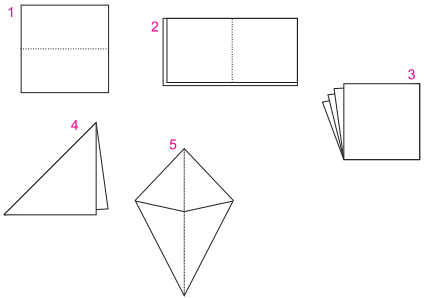
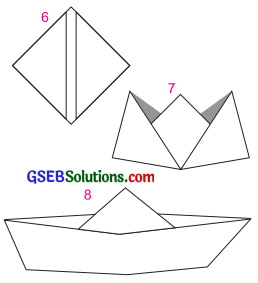
(1) Take a square sheet of paper. Fold it along the middle horizontally.
(ટેક અ સ્કવેઅર શીટ ઑવ પેપર. ફોલ્ડ ઇટ અલોંગ ધ મિડલ હૉરિઝૉન્ટલિ.) એક ચોરસ કાગળ લો. તેને વચ્ચેથી આડો વાળો.
![]()
(2) Then fold it again vertically as shown.
(ધેન ફોલ્ડ ઇટ અગેન વર્ટિકલિ ઍઝ શોન.) પછી બતાવ્યા પ્રમાણે તેને ફરીથી ઊભો વાળો.
(3) You get a folded square.
(યૂ ગેટ અ ફોલ્ડિડ સ્કવેઅર.) તમને વાળેલો ચોરસ મળશે.
(4) Now fold one of the flaps backward.
(નાઉ ફોલ્ડ વન ઑવ ધ લૅપ્સ બેંક્વટ્ઝ.) હવે એક (છૂટો) ભાગ પાછળની તરફ વાળો.
(5) Fold the remaining three flaps as shown.
(ફોલ્ડ ધ રિમેનિંગ થ્રી લૅપ્સ ઍઝ શોન.) બતાવ્યા પ્રમાણે બાકીના ત્રણ ભાગ વાળો.
(6) Now you get a triangle.
(નાઉ યૂ ગેટ અ ટ્રાયેંગલ.) હવે તમને એક ત્રિકોણ ‘ મળશે.
(7) Put your finger inside the triangle to make a cap.
(પુટ યુઅર ફિંગર ઇન્સાઇડ ધ ટ્રાયેંગલ ટુ મેક અ કૅપ.)ટોપી બનાવવા માટે તમારી આંગળી ત્રિકોણમાં મૂકો.
(8) Now make the two ends of the cap meet.
(નાઉ મેક ધ ટુ એડ્ઝ ઑવ ધ કૅપ મીટ.) હવે ટોપીના બંને છેડા મેળવો.
(9) Carefully pull the base.
(કેઅરફુલિ પુલ ધ બેસ.) નીચલો ભાગ કાળજીપૂર્વક ખેંચો.
(10) Pull the flaps outwards.
(પુલ ધ ફ્લેપ્સ આઉર્વર્ડઝ.) (છૂટા) ભાગ બહારની તરફ ખેંચો..
![]()
(11) Press them sideways.
(પ્રેસ ધેમ સાઇડવેઝ.) તેમને (બાજુ તરફ) દબાવો.
(12) Your boat is ready.
(યુઅર બોટ ઇઝ રેડિ.) તમારી હોડી તૈયાર છે.
Activity 2.
(A) Homemade Housefly/ Honey Bee Trap.
Mosquitoes and flies are nasty pests. They spread malaria, cholera and typhoid. We have swarms of flies and mosquitoes in monsoon and winter. We try to kill them. But it is very difficult to catch a fly or a mosquito. So we become the victims of their bites.
We use many insecticides. But they are not much effective. Here is an easy solution. We can prepare a trap to catch and kill the flies and mosquitoes. It is a simple trap.
To make this trap, we require the following things :
- An empty plastic bottle of water
- A pair of scissors
- Cello-tape / gum-tape
- Dish-washing liquid and water
- Food items: very small pieces of apple, 5 grams of sugar and a few drops of lemon juice.
![]()
Follow the instructions :
- Take a plastic bottle. Cut it into two pieces as shown in the picture.
- Remove the cap first. Turn the small piece upside-down. Put the neck part into the bottle.
- Attach the two parts with a staple or a piece of tape.
- Put / drop the food at the bottom of the bottle.
Our device – the mosquito trap is ready. Hang it inside your house or room.

How it works.
Sugar water, dish-washing liquid and other food items will attract the flies and mosquitoes. They will enter the trap. They will fall into the liquid. Their wings will be wet. They will not be able to s fly back.
Note: The distance between the upside-down neck and the liquid at the bottom should not be more than 2 cm.
(હોમમેડ હાઉસફલાઈ / હનિ બી ટ્રેપ.)
માખી / મધમાખી માટે ઘરે બનાવેલ છટકું. | (મૉસ્કીટોઝ ઍન્ડ ફ્લાઇઝ આર નાસ્ટિ પેટ્સ. ધે એડ મલેઅરિઆ, કૉલેરા ઍન્ડ ટાઈફૉઈડ. વી હૈવ સ્વૉઝ ઑવ ફ્લાઇઝ ઍન્ડ મૉસ્કીટોઝ ઇન મસૂન ઍન્ડ વિન્ટર. વી ટ્રાઈ ટુ બિલ ધમ. બટ ઇટ ઇઝ વેરિ ડિફિકલ્ટ ટુ મૅચ અ ફ્લાઇ ઑર આ મૉસુકીટો. સો વી બિકમ ધ વિક્ટિમ્સ ઑવ ધેઅર બાઇટ્સ. વી યુઝ મેનિ ઇન્સેક્ટિસાઇડ્ઝ. બટ ધ આર નૉટ મચ ઇફેકિટવ.
હિઅર ઇઝ ઑન ઇઝિ સુલુશન. વી કૅન પ્રિપેઅર અ ટૅપ ટુ મૅચ ઍન્ડ કિલ ધ ફ્લાઇઝ ઍન્ડ મૉસ્કીટોઝ. ઇટ ઇઝ અ સિમ્પલ ટ્રેપ.) મચ્છર અને માખી અપ્રિય જંતુઓ છે. તે મેલેરિયા, કૉલેરા અને ટાઇફૉઈડ ફેલાવે છે. આપણે ચોમાસામાં અને શિયાળામાં માખીઓ અને મચ્છરોનાં ટોળાં હોય છે. આપણે તેમને મારવાનો પ્રયત્ન કરીએ છીએ. પણ એક માખી કે મચ્છરને પકડવું બહુ મુશ્કેલ છે.
![]()
તેથી આપણે તેમના ડંખના શિકાર બનીએ છીએ. આપણે ઘણી જંતુનાશક દવાઓનો ઉપયોગ કરીએ છીએ. પણ તે ખાસ અસરકારક હોતી નથી. એક સહેલો ઉપાય છે. માખીઓ અને મચ્છરોને પકડવા અને મારવા માટે આપણે એક છટકું બનાવી શકીએ. તે એક સહેલું છટકું છે. (ટ મેક ધિસ ટ્રેપ, વી રિક્વાયર ધ ફૉલોઇંગ થિંગ્સ
આ છટકું બનાવવા માટે, આપણે નીચે મુજબની વસ્તુઓ જોઈશે : (ઍન એષ્ટિ ઑસ્ટિક બૉટલ ઑવ વૉટર) (પાણીની) ખાલી પ્લાસ્ટિકની બૉટલ | (અ પેઅર ઑવ સિઝઝ) કાતર (સેલોટેપ | ગમ-ટેપ) સેલો-ટેપ | ગુંદર-પટ્ટી | (ડિશ-વૉશિંગ લિક્વિડ ઍન્ડ વૉટર) વાસણ સાફ કરવાનું પ્રવાહી અને પાણી
(સેલો-ટેપ } ગમ-ટેપ) સેલો-ટેપ | ગુંદર -પટ્ટી (ડિશ-વૉશિંગ લિક્વિડ ઍન્ડ વૉટર) વાસણ સાફ કરવાનું પ્રવાહી અને પાણી (કુડ આઇટ… : વેરિ સ્મૉલ પીસિઝ ઑવ ઍપલ, 5 ગ્રેઝ ઑવા શુગર ઍન્ડ અ ફ્યૂ ડ્રૉપ્સ ઑવ લેમન જૂસ.) ખાવાની વસ્તુઓ : સફરજનના ઝીણા ટુકડા, 5 ગ્રામ ખાંડ અને લીંબુ શરબતનાં થોડાં ટીપાં. (ટેક અ લૅસ્ટિક બૉટલ. કટ ઇટ ઇન્દુ ટૂ પીસિઝ ઍઝ શોન ઇન ધ પિકચર.)
પ્લાસ્ટિકની બૉટલ લો. ચિત્રમાં દર્શાવ્યા પ્રમાણે તેને બે ભાગમાં કાપો. (રિમૂવ ધ કૅપ ફર્સ્ટ. ટર્ન ધ સ્મૉલ પીસ અસાઇડ-ડાઉન. પુટ ધ નેક પાર્ટ ઇન્દુ ધ બૉટલ.) પહેલાં ઢાંકણું કાઢો. (બૉટલનો) નાનો ભાગ ઊંધો કરો. તેનો કાંઠો (ગળું) બૉટલમાં નાખો.
(અટેચ ધ ટુ પાર્ટ્સ વિથ અ સ્ટેપલ ઑર અ પીસ ઑવ ટેપ.) બંને ભાગને સ્ટેપલથી અથવા (સેલો) ટેપના ટુકડાથી જોડી દો. (પુટ / ડ્રૉપ ધ ફૂડ ઍટ ધ બૉટમ ઑવ ધ બૉટલ.) બૉટલના તળિયે ખાવાની વસ્તુઓ મૂકો. (અવર ડિવાઇસ – ધ મૉસ્કીટો ટૅપ ઇઝ રેડિ. હેંગ ઇટ ઇન્સાઇડ યુઅર હાઉસ ઑર રૂમ.) આપણું સાધન – મચ્છરનું છટકું તૈયાર છે. તમારા ઘરમાં અથવા ઓરડામાં તેને લટકાવી દો.
(શુગર વૉટર, ડિશ-વૉશિંગ લિક્વિડ ઍન્ડ અધર ફુડ આઇટ… વિલ અટ્રેક્ટ ધ ફ્લાઇઝ ઍન્ડ મૉસ્કીટોઝ. ધે વિલ એન્ટર ધ ટ્રેપ. ધે વિલ ફૉલ ઇન્દુ ધ લિક્વિડ. ધેઅર વિંઝ વિલ બી વેટ. ધે વિલ નૉટ બી એબલ ટુ ફ્લાઇ બૅક.) ખાંડનું પાણી, વાસણ સાફ કરવાનું પ્રવાહી અને બીજી ખાવાની વસ્તુઓ માખીઓ અને મચ્છરોને આકર્ષશે.
![]()
તે છટકામાં પ્રવેશ કરશે. તે પ્રવાહીમાં પડશે. તેમની પાંખો ભીની થશે. તે પાછા ઊડી શકશે નહીં. (નોટ : ધ ડિસ્ટન્સ બિન ધ અપ્રસાઇડ – ડાઉન નેક ઍન્ડ ધ લિક્વિડ ઍટ ધ બૉટમ શુડ નૉટ બી મૉર ધેન 2 સેમી.) નોંધ : ઊંધો મૂકેલો ભાગ અને તળિયે મૂકેલા પ્રવાહી વચ્ચેનું અંતર 2 સેમીથી વધુ ન હોવું જોઈએ.
(B) Write [T] True or [F] False in the box. Correct the false statements and write them.
(1) Mosquitoes and flies are our competitors. [F]
Mosquitoes and flies are pests.
(2) Mosquitoes prepare a simple trap to kill men. [F]
Men prepare a simple trap to kill mosquitoes.
(3) Don’t remove the bottom of the bottle. [T]
(4) Two parts of the bottle are attached. ? [T]
(5) Use scissors to cut the food items. [F]
Use scissors to cut the bottle / cello- tape.
![]()
(C) Fill in the blanks using the words in the brackets.
(took, scissors, cut, upside-down, removed, sticky tape, stitched)
Mahesh prepared a mosquito trap. He is describing the steps.
I took a bottle. I cut the bottle with scissors. I removed the cap. Then I put the part upside-down on the bottle. I stitched both the parts with a sticky tape. My trap was ready.
(D) Make a device to catch mosquitoes and flies. Your teacher will help you.
For the teacher:
For the teacher : જરૂરી સામગ્રી : જૂથની સંખ્યા મુજબ બૉટલ Things required: sugar, water, pieces of apple, dish-washing liquid, scissors, cutters, knives, etc.
પાંચ-પાંચ વિદ્યાર્થીઓનાં જૂથ બનાવો. દરેક જૂથને બૉટલ કાપવા માટેની જુદી જુદી વસ્તુઓ આપો. જેમ કે, કાતર, કટર, છરી વગેરે. તેમજ બૉટલના બે ભાગને જોડવા માટે સ્ટેપલર, યુપીન, ક્લિપ જેવી વિવિધ વસ્તુઓ આપો. Mosquito trapમાં નાખવાની ખાવાની વસ્તુઓ પણ અલગ-અલગ આપો. જેમ કે, ખાંડ, પાણી, સફરજન અથવા દ્રાક્ષના ટુકડા, વગેરે. આમ કરવાથી દરેક જૂથનું વર્ણન અલગ-અલગ થશે. દરેક જૂથ પાસે Mosquito trap બનાવવાની રીતનું વર્ણન કરાવો.
![]()
Activity 3.
Read the process – Stitching buttons.
Things required : needle, thread, buttons, piece of cloth
Steps :
(1) Take a needle. Take a thread.
(2) Pass the thread through the needle eye.
(3) Pull the thread length into half so that the two ends are together. Tie a knot.
(4) Place a button at the proper place on the cloth.
(5) Push the needle up through the cloth and through one hole of the button.
(6) Pull the thread upwards fully.
(7) Push the needle down through the second hole and through the cloth.
(8) Pull the thread down fully.
(9) Repeat steps 5 to 8 three or four times.
(10) Finally, push the needle down through a hole and through the cloth. Tie a knot and cut the thread.
(થિંગ્સ રિક્વાયર્ડ: નીડલ, ઘેડ, બટન્ઝ, પીસ ઑવ ક્લૉથ)
જરૂરી વસ્તુઓઃ સોય, દોરો, બટન, કપડાનો ટુકડો (સ્ટેપ્સ પગલાં (ટક અ નીડલ. ટેક અ થ્રેડ.) એક સોય લો. દોરો લો.
(પાસ ધ થ્રેડ યૂ ધ નીડલ આઈ.) સોયમાં દોરો પરોવો. | (પુલ ધ થ્રેડ લેંગ્ય ઈન્ટ હાફ સો ઘંટ ધ ટૂ એડ્ઝ આર ટુગેધર. ટાઈ અ નૉટ.)
દોરો ખેંચી, બરાબર અડધો કરો જેથી તેના બંને છેડા મળે. ગાંઠ બાંધોઃ
(પ્લેસ અ બટન ઍટ ધ પ્રૉપર પ્લેસ ઑન ધ ક્લૉથ.) કપડા પર યોગ્ય જગ્યાએ બટન મૂકો.
(પુશ ધ નીડલ અપ થ્રૂ ધ ક્લૉથ ઍન્ડ યૂ વન હોલ ઑવ ધ બટન.) કપડા નીચેથી સોય નાખી,
ઉપર કાઢો અને બટનના એક કાણામાંથી પસાર કરો.
(પુલ ધ થ્રેડ અવસ્ડ કુલિ.) આખો દોરો ઉપર ખેંચો.
(પુશ ધ નીડલ ડાઉન શૂ ધ સેકન્ડ હોલ ઍન્ડ યૂ ધ ક્લૉથ.)
(બટનના) બીજા કાણામાં સોય નાખો અને કપડામાંથી પસાર કરી, નીચે લાવો.
(પુલ ધ થ્રેડ ડાઉન ફલિ.) આખો દોરો નીચે ખેંચો.
(રિપીટ સ્ટેપ્સ 5 ટૂ 8 થી ઑર ફૉર ટાઇમ્સ.) પગલાં 5થી 8 ત્રણથી ચાર વાર કરો.
(ફાઇનલિ, પુશ ધ નીડલ ડાઉન થૂ અ હોલ ઍન્ડ યૂ ધ ક્લૉથ. ટાઈ અ નૉટ ઍન્ડ કટ ધ ગ્રેડ.) અંતે,
(બટનના) કાણામાંથી સોય નાખી, કપડામાંથી પસાર કરી, નીચે લાવો. ગાંઠ બાંધી, દોરો કાપો.
![]()
Activity 4.
Read the dialogue.
Mahesh wants to open an account in a bank. He goes to the bank. He meets the manager.
Mahesh : May I come in, sir ?
Manager: Yes, you may. What can I do for you?
Mahesh: I want an SD account to be opened in the bank.
Manager: OK, take this form. Fill in the details.
Mahesh: Sir, I have filled up the form.
Manager: Now paste your photograph and sign it.
Mahesh : Here it is.
Manager: How much money do you want me to deposit?
Mahesh: ₹ 500.
Manager: OK, now give your form and money to the cashier. He will give you a passbook.
Mahesh : Thank you, sir.
(મહેશ વૉન્ટ્સ ટુ ઓપન ઍન અકાઉન્ટ ઇન અ બેંક. હી ગોઝ ટૂ ધ બેંક. હી મીટ્સ ધ મનેજર.) મહેશને એક બેંકમાં ખાતું ખોલવું છે. તે બેંકમાં જાય છે. તે મનેજર(સંચાલકોને મળે છે. (મે આઈ કમ ઇન, સર?) હું અંદર આવી શકે, સાહેબ? (યસ, યૂ મે. વૉટ કેન આઈ ડૂ ફૉર યૂ?) હા, તમે ‘આવી) શકો છો.
હું તમારા માટે શું કરી શકું? (આઈ વૉન્ટ ઍન SD અકાઉન્ટ ટુ બી ઓપનુડ ઇન ધ બેંક.). મારે બેંકમાં SD ખાતું ખોલાવવું છે. (ઓકે, ટેક ધિસ ફૉર્મ. ફિલ ઈન ધ ડીટેચ્છ.) સારું, આ ફૉર્મ લે. બધી માહિતી ભર. (સર, આઈ હેવ ફિલ્ડ અપ ધ ફૉર્મ.) સાહેબ, મેં ફૉર્મ ભર્યું છે. (નાઉ પેસ્ટ યુઅર ફોટગ્રાફ ઍન્ડ સાઇન ઇટ.)
![]()
હવે તારો ફોટોગ્રાફ ચોંટાડીને સહી કર. (હિઅર ઇટ ઇઝ.) આ રહ્યું. (હાઉ મચ મનિ ડૂ યૂ વૉન્ટ મી ટૂ પિૉઝિટ?) તું તમારી પાસે) કેટલા પૈસા જમા કરવા માગે છે? (ર 500.) 7500. (ઓકે, નાઉ ગિવ યુઅર ફૉર્મ ઍન્ડ મનિ ટૂ ધ કેશિઅર. હી વિલ ગિવ યૂ અ પાસબુક.) સારું, હવે તારું ફૉર્મ અને પૈસા કેશિઅરને આપ. તે તને એક પાસબુક આપશે. (થેંક યુ, સર.) આભાર, સાહેબ.
Activity 5.
Study the form. Fill in the details. Your teacher will help you.
For the teacher: જુદી જુદી બેંકમાંથી ખાતાં ખોલાવવાનાં ફૉર્મ વર્ગમાં લાવીને, વિદ્યાર્થીઓને બતાવો.

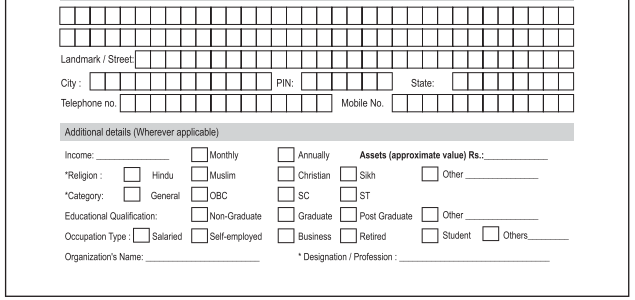
![]()

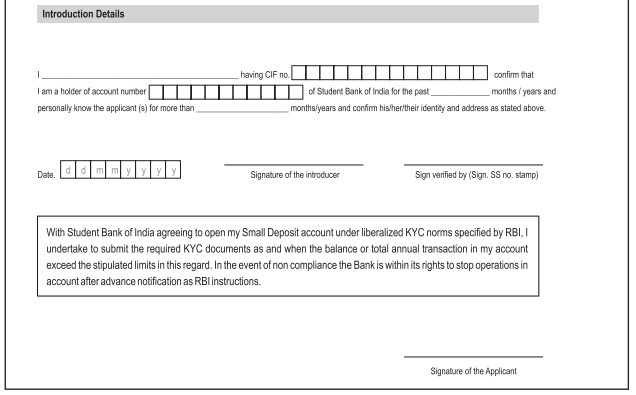
Activity 6.
(A) Work in pairs.
Laxman prepared a set of cards to show how to make lemon sharbat. But he forgot to write the instructions for each card. Write the instructions in the blanks.
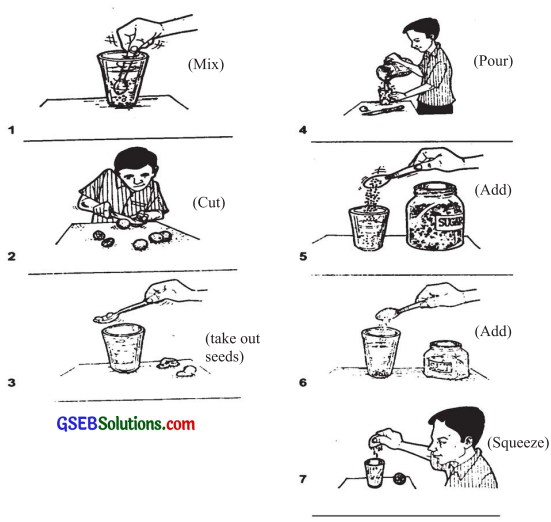
1. Mix Well
2. Cut lemons into half
3. take out the seeds from the glass
4. Pour some water into glass
5. Add one spoon of sugar
6. Add a tittle salt
7. Squeeze each half piece into the water.
![]()
(B) Arrange the sentences. Read the process of lemon sharbat.
(1) Laxman poured some water in the glass.
(2) He cut the lemons into half.
(3) He squeezed each half piece into the glass.
(4) He took out the seeds from glass.
(5) He added some sugar.
(6) He then added a little salt.
(7) He mixed the sharbat well.
(C) Answer the following questions.
Question 1.
What did Laxman use to mix sugar ?
Answer:
Laxman used a spoon to mix sugar.
Question 2.
How much sugar did Laxman add ?
Answer:
Laxman added one spoon of sugar.
Question 3.
When did Laxman use a spoon ?
Answer:
Laxman used a spoon to take out the seeds, to add sugar, to add salt and to mix the sharbat.
Question 4.
What did Laxman do after squeezing the lemon ?
Answer:
After squeezing the lemon, Laxman took out the seeds from the glass.
Question 5.
Why did Laxman add salt in it ?
Answer:
Laxman added salt for taste.
Activity 7.
Read the process.
For the teacher : ધોરણ 7 – વિજ્ઞાન અને ટેકનૉલજિ – પ્રથમ સત્ર – પાઠ 4નો સંદર્ભ આપીને વિદ્યાર્થીઓ સાથે ચર્ચા કરો.
Material:
Half cut plastic jar, two screws, copper wire, two test tubes, dry battery cells or 6-volt battery, sulphuric acid
Procedure:
(1) Take a plastic jar (cut into half) as shown in the picture. Make two holes at the bottom of the jar. Fit the screws into the holes. Remember, there should not be any water leakage.
![]()
(ટેક અ ઑસ્ટિક જાર (કટ ઇન્ટ હાફ) ઍઝ શોન ઇન ધ પિશ્ચર. મેક ટુ હોલ્ટ ઍટ ધ બૉટમ ઑવ ધ જાર. ફિટ ધ સ્કૂઝ ઇન્દુ ધ હોલ્ડ. રિમેમ્બર, ધેઅર શુડ બી નૉટ બી ઍનિ વૉટર લીકિજ.] ચિત્રમાં દર્શાવ્યા પ્રમાણે, એક (અડધી કાપેલી) પ્લાસ્ટિકની બરણી લો. બરણીના તળિયામાં બે કાણાં કરો. ખીલીઓ તે કાણાંમાં બરાબર બેસાડી દો. યાદ રાખો (ક) પાણી ચૂવું ન જોઈએ.
(2) Join the outer ends of the screws with a battery or a dry cell. This is our voltmeter.
(3) Now fill half of the voltmeter with pure water.
(4) Add four or five drops of sulphuric acid.
(5) Water will become a good conductor.
(મટિઅરિઅલ : હાફ કટ ઑસ્ટિક જાર, ટૂ સ્કૂઝ, કૉપર વાયર, ટૂ ટેસ્ટ ટ્યૂડ્ઝ, ડ્રાઈ બૅટરિ સેલ્થ ઑર 6 વોલ્ટ
બૅટરિ, સફ્યુઅરિક ઍસિડ)
સામગ્રી : અડધી કાપેલી પ્લાસ્ટિકની બરણી, બે ખીલીઓ, તાંબાનો વાયર (તાર), બે ટેસ્ટ ટ્યૂબ, બૅટરિ સેલ અથવા 6 વોલ્ટ બૅટરિ, સફ્યુરિક ઍસિડ)
(પ્રસીજર પદ્ધતિ

(જોઈન ધ આઉટર એડ્ઝ ઑવ ધ ક્રૂઝ વિથ અ બૅટરિ ઑર અ ડ્રાઈ સેલ. ધિસ ઇઝ અવર વોલ્ટમીટર.)
ખીલીઓના બહારના છેડા બૅટરિ અથવા સેલ સાથે જોડો. આ આપણું વોલ્ટમીટર છે.
(નાઉ ફિલ હાફ ઑવ ધ વોલ્ટમીટર વિથ પ્યુઅર વૉટર.)
હવે અડધું વોલ્ટમીટર ચોખ્ખા પાણીથી ભરો.
(ઍડ ફૉર ઑર ફાઇવ ડ્રૉસ ઑવ સફ્યુઅરિક ઍસિડ.)
સફ્યુરિક ઍસિડનાં ચારથી પાંચ ટીપાં નાખો.
(વૉટર વિલ બિકમ અ ગુડ કન્ડક્ટર.)
પાણી (વીજળીનું) સારું વાહક બની જશે.
![]()
Activity 8.
Mega Ride.
Gujarat is a progressive state. Ahmadabad is the largest city and a centre of business in Gujarat. Gandhinagar is the capital of Gujarat. Every day, about 50,000 people travel between these two capitals-old and new. So we need a good transport facility.
The Government of Gujarat planned for a new railway project. The government started a ₹ 2000 crores (₹ 20,00,00,00,000) company for that project. The name of the company is MEGA – Metro-link Express for Gandhinagar and Ahmadabad. The cost of this project is about ₹ 1200 crores (₹12,00,00,00,000).
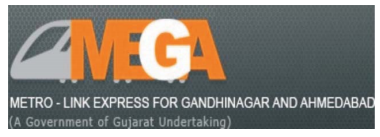
This metro-rail project has two phases. In the first phase, there will be three lines : North-South corridor, East-West corridor and underground corridor. Total length of all the three lines will be 76 km.
The North-South corridor will connect Ashram Road to Gandhinagar. This corridor will be 32.65 km long. It will start from APMC, Vasna on National Highway 8A. It will pass through Vasna, Paldi, V S. Hospital and Town Hall.
This line will cross the East-West corridor at Income-Tax junction. It will turn a little left near Coba circle and will run towards Gandhinagar. There are two more junctions on this line : Info City and GIFT City. There will be 31 stations on this corridor.
Now let us go on the East-West corridor. It will start from Kalupur. It will run through the main areas of Ahmadabad. Then the line will turn south towards IT circle. It will go towards Commerce crossing. Thaltej crossing will be the last station of this route. It will be the terminus on the East-West corridor. Total length of this line will be 10.90 kms. It will connect the eastern and western Ahmadabad.
Most of the metro route will be on pillars and over-bridges. This will be called elevated route. The travellers will enjoy the beautiful scenes in the town. It will be a lovely view to see metro trains running on elevated tracks.
![]()
(મોસ્ટ ઑવ ધ મેટ્રો રૂટ વિલ બી ઑન પિલર્ઝ ઍન્ડ ઓવર બ્રિજિઝ. ધિસ વિલ બી કૉલ્ડ એલિવેટિડ રૂટ, ધ ટ્રેવલર્ગ વિલ ઇનજૉઇ ધ બ્યુટિફુલ સીન્ઝ ઇન ધ ટાઉન. ઇટ વિલ બી એ લલિ યૂ ટુ સી મેટ્રો ટ્રેન્ડ રનિંગ ઑન એલિવેટિડ ટ્રેક્સ.) મોટા ભાગનો મેટ્રો રૂટ થાંભલા અને ઓવર બ્રિજ પર હશે. તેને એલિવેટિડ રૂટ ઊંચો માર્ગ) કહેવામાં આવશે. મુસાફરો શહેરનાં સુંદર દૃશ્યોનો આનંદ માણશે. ઊંચા પાટા પર દોડતી મેટ્રો ગાડીઓ જોવી, તે એક સુંદર દશ્ય હશે.
You will be able to travel without tickets in this metro rail. You can use smart card facility. You can enter a station with your smart card. You swipe the smart card at your exit station. The system will automatically count the travel charges. The trains will run without drivers. But you need not worry. Technology will take charge of your safety. CBTC (Communication Based Train Control) signalling technology will make your travel safe.
All metro cars will be air-conditioned. The train will travel at the maximum speed of 110 km per hour. Ready for the ride?
(મેગા રાઈs) મેગા (લાંબો) પ્રવાસ
(ગુજરાત ઇઝ અ પ્રગ્રેસિવ સ્ટેટ. એહમદાબાદ ઇઝ ધ લાર્જિસ્ટ સિટિ ઍન્ડ અ સેન્ટર ઑવ બિનિસ ઇન ગુજરાત. ગાંધીનગર ઇઝ ધ કૅપિટલ ઑવ ગુજરાત. એવરિ ડે, અબાઉટ 50,000 પીપલ ટ્રેવલ બિટ્વીન ધીઝ ટુ કૅપિટલ્ડ – ઓલ્ડ ઍન્ડ ન્યૂ. સો વી નીડ અ ગુડ ફૅન્સપોર્ટ સિલિટિ.)
ગુજરાત એક પ્રગતિશીલ રાજ્ય છે. ગુજરાતમાં અમદાવાદ સૌથી મોટું શહેર અને વેપારનું કેન્દ્ર છે. ગાંધીનગર ગુજરાતની રાજધાની છે. રોજ, લગભગ 50,000 લોકો આ બંને રાજધાનીઓ – જૂની અને નવી – વચ્ચે પ્રવાસ કરે છે. તેથી આપણને એક સારી પરિવહન સગવડ(વ્યવસ્થા)ની જરૂર છે. [ધ ગવર્નમેન્ટ ઑવ ગુજરાત ગ્લૅન્ડ ફૉર અ ન્યૂ રેલવે પ્રજેક્ટ, ધ ગવર્નમેન્ટ સ્ટાર્ટિડ અ ₹ 2000 ક્રોર (₹ 20,00,00,00,000) કમ્પનિ ફૉર ધેટ પ્રજેક્ટ.
ધ નેમ ઑવ ધ કમ્પનિ ઇઝ MEGA – મેટ્રો-લિંક ઇસપ્રેસ ફૉર ગાંધીનગર ઍન્ડ એહમદાબાદ, ધ કૉસ્ટ ઑવ ધિસ પ્રજેકટ ઇઝ અબાઉટ ₹ 1200 ક્રોર (12,00,00,00,000)] ગુજરાત સરકારે એક નવી રેલવે યોજનાનું આયોજન કર્યું. સરકારે તે યોજના માટે ₹ 2000 કરોડની એક કંપની શરૂ કરી. કંપનીનું નામ છે – MEGA – મેટ્રો-લિંક એક્સપ્રેસ ફૉર ગાંધીનગર ઍન્ડ અમદાવાદ. આ યોજનાનો ખર્ચ લગભગ 1200 કરોડ (₹ 12,00,00,00,000) છે.
(લિસ મેટ્રો-રેલ પ્રજેકટ હેંઝ ટુ ફેઝિઝ. ઇન ધ ફર્સ્ટ ફેઝ, ધેઅર વિલ બી થી લાઇન્સ : નૉર્થ-સાઉથ કૉરિડૉર, ઇસ્ટ-વેસ્ટ કૉરિડૉર ઍન્ડ અન્ડરગ્રાઉન્ડ કૉરિડૉર. ટોટલ લેંગ્યુ ઑવ ઑલ ધ શ્રી લાઇ— વિલ બી 76 કિમી.) આ મેટ્રો-રેલ યોજનાના બે તબક્કા છે. પહેલાં તબક્કામાં, ત્રણ લાઇન હશે : ઉત્તર-દક્ષિણ કૉરિડૉર (રસ્તો), પૂર્વ-પશ્ચિમ કૉરિડૉર અને અન્ડરગ્રાઉન્ડ (ભૂગર્ભ) કૉરિડૉર. ત્રણે લાઇનની કુલ લંબાઈ 76 કિમી છે.
(ધ નૉર્થ-સાઉથ કૉરિડૉર વિલ કનેકટ આશ્રમ રોડ ટુ ગાંધીનગર. ધિસ કૉરિડૉર વિલ બી 32.65 કિમી લોંગ. ઇટ વિલ સ્ટાર્ટ ફ્રૉમ APMC, વાસણા ઑન નૅશનલ હાઈવે 8A. ઇટ વિલ પાસ થ્ર વાસણા, પાલડી, વી. એસ. હૉસ્પિટલ ઍન્ડ ટાઉન હૉલ.) ઉત્તર-દક્ષિણ કૉરિડૉર આશ્રમ રોડને ગાંધીનગર સાથે જોડશે.
![]()
આ કૉરિડૉર 32.65 કિમી લાંબો હશે. તે નૅશનલ હાઈવે 8A પર (આવેલ) વાસણામાં APMCથી શરૂ થશે. તે વાસણા, પાલડી, વી. એસ. હૉસ્પિટલ અને ટાઉન હૉલથી પસાર થશે. (લિસ મેટ્રો-રેલ પ્રજેકટ હેંઝ ટુ ફેઝિઝ. ઇન ધ ફર્સ્ટ ફેઝ, ધેઅર વિલ બી થી લાઇન્સ : નૉર્થ-સાઉથ કૉરિડૉર, ઇસ્ટ-વેસ્ટ કૉરિડૉર ઍન્ડ અન્ડરગ્રાઉન્ડ કૉરિડૉર. ટોટલ લેંગ્યુ ઑવ ઑલ ધ શ્રી લાઇ વિલ બી 76 કિમી.)
આ મેટ્રો-રેલ યોજનાના બે તબક્કા છે. પહેલાં તબક્કામાં, ત્રણ લાઇન હશે : ઉત્તર-દક્ષિણ કૉરિડૉર (રસ્તો), પૂર્વ-પશ્ચિમ કૉરિડૉર અને અન્ડરગ્રાઉન્ડ (ભૂગર્ભ) કૉરિડૉર. ત્રણે લાઇનની કુલ લંબાઈ 76 કિમી છે. (ધ નૉર્થ-સાઉથ કૉરિડૉર વિલ કનેકટ આશ્રમ રોડ ટુ ગાંધીનગર. ધિસ કૉરિડૉર વિલ બી 32.65 કિમી લોંગ. ઇટ વિલ સ્ટાર્ટ ફ્રૉમ APMC, વાસણા ઑન નૅશનલ હાઈવે 8A.
ઇટ વિલ પાસ થ્ર વાસણા, પાલડી, વી. એસ. હૉસ્પિટલ ઍન્ડ ટાઉન હૉલ.) ઉત્તર-દક્ષિણ કૉરિડૉર આશ્રમ રોડને ગાંધીનગર સાથે જોડશે. આ કૉરિડૉર 32.65 કિમી લાંબો હશે. તે નૅશનલ હાઈવે 8A પર (આવેલ) વાસણામાં APMCથી શરૂ થશે. તે વાસણા, પાલડી, વી. એસ. હૉસ્પિટલ અને ટાઉન હૉલથી પસાર થશે.
(લિસ મેટ્રો-રેલ પ્રજેકટ હેંઝ ટુ ફેઝિઝ. ઇન ધ ફર્સ્ટ ફેઝ, ધેઅર વિલ બી થી લાઇન્સ : નૉર્થ-સાઉથ કૉરિડૉર, ઇસ્ટ-વેસ્ટ કૉરિડૉર ઍન્ડ અન્ડરગ્રાઉન્ડ કૉરિડૉર. ટોટલ લેંગ્યુ ઑવ ઑલ ધ શ્રી લાઇ વિલ બી 76 કિમી.) આ મેટ્રો-રેલ યોજનાના બે તબક્કા છે. પહેલાં તબક્કામાં, ત્રણ લાઇન હશે : ઉત્તર-દક્ષિણ કૉરિડૉર (રસ્તો), પૂર્વ-પશ્ચિમ કૉરિડૉર અને અન્ડરગ્રાઉન્ડ (ભૂગર્ભ) કૉરિડૉર. ત્રણે લાઇનની કુલ લંબાઈ 76 કિમી છે.
(ધ નૉર્થ-સાઉથ કૉરિડૉર વિલ કનેકટ આશ્રમ રોડ ટુ ગાંધીનગર. ધિસ કૉરિડૉર વિલ બી 32.65 કિમી લોંગ. ઇટ વિલ સ્ટાર્ટ ફ્રૉમ APMC, વાસણા ઑન નૅશનલ હાઈવે 8A. ઇટ વિલ પાસ થ્ર વાસણા, પાલડી, વી. એસ. હૉસ્પિટલ ઍન્ડ ટાઉન હૉલ.) ઉત્તર-દક્ષિણ કૉરિડૉર આશ્રમ રોડને ગાંધીનગર સાથે જોડશે.
આ કૉરિડૉર 32.65 કિમી લાંબો હશે. તે નૅશનલ હાઈવે 8A પર (આવેલ) વાસણામાં APMCથી શરૂ થશે. તે વાસણા, પાલડી, વી. એસ. હૉસ્પિટલ અને ટાઉન હૉલથી પસાર ટેક્સ જંકશન. ઇટ વિલ ટર્ન અ લિટલ લેફ્ટ નિઅર કોબા સર્કલ ઍન્ડ વિલ રન ટવૉર્ડ્ઝ ગાંધીનગર. ધેઅર આર ટૂ મૉર જંકશન્સ ઑન ધિસ લાઇન : ઇન્ફો સિટિ ઍન્ડ GIFT સિટિ. ધેઅર વિલ બી 31 સ્ટેશન્ઝ ઑન ધિસ કૉરિડૉર.)
આ લાઇન ઇન્કમ-ટૅક્સ જંકશન પર પૂર્વ-પશ્ચિમ કૉરિડૉરને મળશે. કોબા સર્કલથી થોડી ડાબી તરફ વળી, તે ગાંધીનગર તરફ જશે. આ લાઇન પર બીજાં બે જંકશન છે : ઇન્ફો સિટિ અને GIFT સિટિ. આ કૉરિડૉર પર 31 સ્ટેશન હશે. (નાઉ લેટ અસ ગો ટુ ધ ઇસ્ટ-વેસ્ટ કૉરિડૉર. ઇટ વિલ સ્ટાર્ટ ફ્રૉમ કાલુપુર. ઇટ વિલ રન શૂ ધ મેન એઅરિઝ ઑવ એહમદાબાદ, ધન ધ લાઇન વિલ ટર્ન સાઉથ ટવૉર્ડ્ઝ IT સર્કલ.
![]()
ઇટ વિલ ગો ટવૉર્ડઝ કૉમર્સ ક્રૉસિંગ. થલતેજ ક્રૉટિંગ વિલ બી ધ લાસ્ટ સ્ટેશન ઑફ ધિસ રૂટ, ઇટ વિલ બી ધ ટર્મિનસ ઑન ધ ઇસ્ટવેસ્ટ કૉરિડૉર. ટોટલ લેંગ્યુ ઑવ ધિસ લાઇન વિલ બી 10.90 કિમી. ઇટ વિલ કનેક્ટ ધ ઇસ્ટર્ન ઍન્ડ વેસ્ટર્ન એહમદાબાદ) હવે આપણે પૂર્વ-પશ્ચિમ કૉરિડૉર પર જઈએ. તે કાલુપુરથી શરૂ થશે.
તે અમદાવાદના મુખ્ય વિસ્તારોમાંથી પસાર થશે. પછી આ લાઇન IT સર્કલ તરફ દક્ષિણમાં વળશે. તે કૉમર્સ ક્રૉસિંગ તરફ જશે. આ રૂટ(માર્ગ)નું છેલ્લું સ્ટેશન થલતેજ સ્ટેશન હશે. તે પૂર્વ-પશ્ચિમ કૉરિડૉરનું ટર્મિનસ હશે. આ લાઇનની કુલ લંબાઈ 10.90 કિમી હશે. તે પૂર્વ અને પશ્ચિમ અમદાવાદને જોડશે.
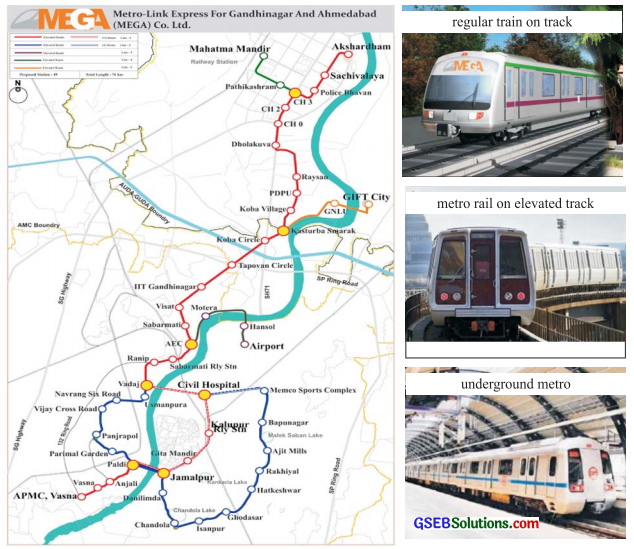
નોંધ : આ નકશો મોટી સાઇઝમાં પેજ નં. 128 પર છાપેલ છે.
યુ વિલ બી એબલ ટ્ર ટ્રેવલ વિધાઉટ ટિકિટ્સ ઇન ધિસ મેટ્રો રેલ. યુ કૅન યૂઝ સ્માર્ટ કાર્ડ ફસિલિટિ, યૂ કૅન એન્ટર અ સ્ટેશન વિથ યુઅર સ્માર્ટ કાર્ડ. યુ સ્વાઇપ ધ સ્માર્ટ કાર્ડ ઍટ યુઅર એઝિટ સ્ટેશન. ધ સિસ્ટિમ વિલ ઑટમૅટિકલિ કાઉન્ટ ધ ટ્રેવલ ચાર્જિઝ, ધ ટ્રેન્ડ વિલ રન વિધાઉટ ડ્રાઇવર્ઝ. બટ યૂ નીડ નૉટ
વરિ. ટેકનૉલજિ વિલ ટેક ચાર્જ ઑવ યુઅર સેટિ. CBTC (કમ્યુનિકેશન એન્ડ ટ્રેન કન્ટ્રોલ) સિગ્નલિંગ ટેક્નૉલજિ વિલ મેક યુઅર ટ્રેવલ સેફ.] આ મેટ્રો રેલમાં તમે ટિકિટ વિના પ્રવાસ કરી શકશો. તમે સ્માર્ટ કાર્ડ વાપરી શકો. તમે સ્માર્ટ કાર્ડનો ઉપયોગ કરી સ્ટેશનમાં પ્રવેશી શકો.
![]()
તમારા બહાર નીકળવાના સ્ટેશન પર તમે સ્માર્ટ કાર્ડ સ્વાઇપ કરશો. (યાંત્રિક) વ્યવસ્થા તેની મેળે પ્રવાસનું ભાડું ગણશે. ટ્રેન ડ્રાઇવર વિના દોડશે. પણ તમારે ચિંતા કરવાની જરૂર નથી. ટેકનૉલજિ (તંત્રજ્ઞાન) તમારી સુરક્ષાની જવાબદારી લેશે. CBTC (કમ્યુનિકેશન બેડ ટ્રેન કન્ટ્રોલ) સિગ્નલ ટેકનૉલજિ તમારો પ્રવાસ સુરક્ષિત કરશે.
(ઑલ મેટ્રો કાર્ઝ વિલ બી એઅર-કન્ડિશન્ડ. ધ ટ્રેન વિલ ટ્રેવલ ઍટ ધ મૅક્સિમમ સ્પીડ ઑવ 110 કિમી પર આવર. રેડિ ફૉર ધ રાઇડ?) બધી જ મેટ્રો કાર (ડબ્બા) એઅર-કન્ડિશન્ડ (વાતાનુકુલિત) હશે. ટ્રેન કલાકની અધિકતમ 110 કિમીની ઝડપે દોડશે. પ્રવાસ માટે તૈયાર છો?
(B) Put a cross on the wrong option and make the statement true. Read aloud.
(1) The Bast-West / ✗North-South corridor will connect two parts of Ahmadabad.
(2) Travellers will travel in MEGA trains with a ✗ ticket / smart card.
(3) Most of the metro trains will run on ✗underground / elevated route.
(4) The MEGA trains will run ✗with/without drivers.
(5) The terminus for East-West corridor will be Thaltej crossing / Ealupur ✗
(C) Answer the questions.
Question 1.
How many lines will be there in the first phase of MEGA ? Name them.
Answer:
There will be three lines in the first phase of MEGA.
(1) North-South corridor,
(2) East-West corridor and
(3) underground corridor.
Question 2.
Which line will connect eastern and western Ahmadabad ?
Answer:
The East-West corridor will connect the eastern and western Ahmadabad.
Question 3.
What will be the total distance between Kalupur and Thaltej crossing ?
Answer:
The total distance between Kalupur and Thaltej crossing will be 10.90 km.
Question 4.
What does elevated route mean ?
Answer:
The elevated route will be on pillars and over-bridges.
![]()
Question 5.
Write three specialities of MEGA trains.
Answer:
1. It will have smart-card facility.
2. Trains will run without drivers.
3. All metro cars will be air- conditioned.
Question 6.
What is the capital city of Gujarat ?
Answer:
Gandhinagar is the capital city of Gujarat.
Question 7.
Why do we need a good transport facility ?
Answer:
We need a good transport facility because every day, about 50,000 people travel between Ahmadabad and Gandhinagar.
Question 8.
Which corridor will connect Ashram Road to Gandhinagar?
Answer:
The North-South corridor will connect Ashram Road to Gandhinagar.
Question 9.
Which is the last station of the East-West corridor?
Answer:
Thaltej crossing will be the last station of the East-West corridor.
Question 10.
What will be the maximum speed of the trains ?
Answer:
The maximum speed of the trains will be 110 km per hour.
(D) Former President of India, Dr APJ Abdul Kalam will meet the students ‘ at Mahatma’ Mandir on 15th January.You will reach Ahmadabad from your place. Which MEGA route will you take to reach Mahatma Mandir?
Answer:
(1) If I am at the railway station or the bus stop, I will take the East-West corridor to reach Mahatma Mandir.
(2) If I am in Ahmadabad (around Vasna; Paldi, Town Hall or V. S. Hospital), I will take the North-South corridor to reach Mahatma Mandir.
![]()
Activity 9.
(A) Work in groups of four. Plan a one- day trip with low cost and lots of fun. Select an option for each question.
Question 1.
Where will you go ?
(A) nearby farm
(B) nearby bazaar
(C) nearby water park
Answer:
(A) nearby farm
Question 2.
How will you go ?
(A) on a bicycle
(B) by shared rickshaw
(C) by friend’s car
Answer:
(A) on a bicycle
Question 3.
What will you carry ?
(A) fruits
(B) ready-made snacks
(C) raw material for cooking
Answer:
raw material for cooking
Question 4.
What will you do there ?
Answer:
We will play games, sing, dance, cook food and enjoy ourselves.
(5) What will be the cost of your trip ?
| (1) Ticket from my city/town/village | ₹00 |
| (2) Food items on the way | ₹00 |
| (3)Lunch | ₹200 |
| (4) Sight-seeing | ₹00 |
| (5) Shopping | ₹00 |
| (6) Auto fares | ₹00 |
| (7) Miscellaneous expenses | ₹100 |
| Total | ₹300 |
(B) You have started a company of biscuits/chocolates/bikes/clothes. Prepare a logo for your company.
(બિસ્કિટ, ટુથપેસ્ટ, દવા, વગેરેનાં wrappers એકઠાં કરો. તેમના પર આપેલ કંપનીના લોગોનાં ચિત્રો જુઓ અને તમારા શિક્ષક સાથે ચર્ચા કરો.)
Recite, sing and enjoy.
Tree-Huggers.
Release it now, just like a big balloon …
A prayer to reach the mountains of the moon. To the citizens of the Earth, alas we say: Go find yourself a tree to hug today!
And if a grown-up says: Don’t be a fool!
Or is that what they are teaching you in school ? Just find this poem and read this simple rhyme. It’s cool to HUG a TREE from time to time!
Children, this is how the world can be Making Earth plan A and not plan B.
Wear change! Share change! Sing change! Bring change!
And start by hugging a tree !
![]()
ટ્રી-હાર્ટ
(રિલીઝ ઇટ નાઉ, જસ્ટ. લાઇક અ બિગ બલુન …)
(અ.પ્રેઅર ટૂ રીચ ધ માઉન્ટિન્ઝ ઑવ ધ મૂન.) ૬
(ટૂ ધ સિટિઝન્ઝ ઑવ ધ અર્થ, અલાસ વી ?
(ગો ફાઇન્ડ યુઅરસેલ્ફ અ ટ્રી ટૂ હગ ટૂડે !)
(ઍન્ડ ઇફ અ ગ્રોન-અપ સેઝઃ ડોન્ટ બી અ ફૂલ!)
(ઑર ઇઝ ધેટ વૉટ ધ આર ટીચિંગ ન્યૂ ઇન સ્કૂલ?)
(જસ્ટ ફાઇન્ડ ધિસ પોઇમ ઍન્ડ રીડ ધિસ સિમ્પલ રાઇમ.)
(ઇટ્સ કૂલ ટૂ હગ અ ટ્રી ફ્રૉમ યઇમ ટૂ ટાઇમ!)
(ચિલ્ડ્રન, ધિસ ઇઝ હાઉ ધ વર્લ્ડ કૅન બી…)
(મેકિંગ અર્થ પ્લેન A ઍન્ડ નૉટ પ્લેન B.)
(વેઅર ચેન્જ! શેઅર ચેન્જ! સિંગ ચેન્જ! બિંગ ચેન્જ!)
(ઍન્ડ સ્ટાર્ટ બાઈ હગિંગ અ ટ્રી!).
Let’s Learn More
Read the following paragraphs from the lesson.
(1) Gujarat is a progressive state. Ahmadabad is the largest city and a centre of business in Gujarat. Gandhinagar is the capital of Gujarat. Every day, about 50,000 people travel between these two capitals-old and new. So we need a good transport facility.
Answer the following questions.
Question 1.
What is the capital city of Gujarat?
Answer:
Gandhinagar is the capital city of Gujarat.
Question 2.
Why do we need a good transport facility ?
Answer:
We need a good transport facility because every day, about 50,000 people travel between Ahmadabad and Gandhinagar.
Answer the questions selecting the correct options.
Question 1.
We need a good …………. facility.
A. road
B. transport
C. rail
D. education
Answer:
B. transport
Question 2.
…………… is the largest city.
A. Surat
B. Gandhinagar
C. Vadodara
D. Ahmadabad
Answer:
D. Ahmadabad
Question 3.
…………… is the capital city.
A. Gandhinagar
B. Ahmadabad
C. Gandhigram
D. Gandhidham
Answer:
A. Gandhinagar
![]()
Question 4.
Gujarat is a ………… state.
A. conservative
B. traditional
C. progressive
D. slow
Answer:
C. progressive
Question 5.
Ahmadabad is the centre of …………
A. culture
B. business
C. food
D. clothes
Answer:
B. business
Question 6.
How many people travel between Ahmadabad and Gandhinagar every day?
A. 500
B. 5,000
C. 50,000
D. 500,000
Answer:
C. 50,000
(2) The Government of Gujarat planned for a new railway project. The government started a ₹ 2000 crores (₹20,00,00,00,000) company for that project. The name of the company is MEGA – Metro-link Express for Gandhinagar and Ahmadabad. The cost of this project is about ₹ 1200 crores (₹12,00,00,00,000).
Answer the following questions.
Question 1.
What has the Government of Gujarat planned ?
Answer:
The Government of Gujarat has planned a new railway project.
Question 2.
What is the name of the company started by the government?
Answer:
The name of the company started by the government is MEGA.
Answer the questions selecting the correct options.
Question 1.
MEGA means …
A. Metro-link Express for Gandhinagar and Ahmadabad.
B. Metro-link Express for Gandhidham and Ahmadabad.
C. Metro-link Express for Gandhigram and Ahmadabad.
D. Metro-link Express for Gandhinagar and Surat
Answer:
A. Metro-link Express for Gandhinagar and Ahmadabad.
Question 2.
The cost of the project is ……….. crores.
A. 12
B. 120
C. 1200
D. 12,000
Answer:
C. 1200
![]()
(3) This metro-rail project has two phases. In the first phase, there will be three lines: North-South corridor, East-West corridor and underground corridor. Total length of all the three lines will be 76 km.
Answer the following questions.
Question 1.
How many lines will be there in the first phase of MEGA? Name them.
Answer:
There will be three lines in the first phase of MEGA.
(1) North-South corridor
(2) East-West corridor and
(3) underground corridor.
Question 2.
What is the total length of the three lines ?
Answer:
The total length of the three lines will be 76 km.
Answer the questions selecting the correct options.
Question 1.
The total length of the three lines will be ………… km.
A. 76
B. 67
C. 66
D. 77
Answer:
A. 76
Question 2.
Which word in the passage means ‘stages’ ?
A. length
B. lines
C. corridors
D. phases
Answer:
D. phases
(4) The North-South corridor will connect Ashram Road to Gandhinagar. This corridor will be 32.65 km long. It will start from APMC, Vasna on National Highway 8A. It will pass through Vasna, Paldi, V. S. Hospital and Town Hall.
Answer the following questions.
Question 1.
Which corridor will connect Ashram Road to Gandhinagar ?
Answer:
The North-South corridor will connect Ashram Road to Gandhinagar.
Question 2.
What will be the length of the North- South corridor?
Answer:
The length of the North-South corridor will be 32.65 km.
![]()
Question 3.
From where will the North-South corridor start?
Answer:
The North-South corridor will start from APMC, Vasna.
Answer the questions selecting the correct options.
Question 1.
The North-South corridor will connect
A. Vasna to Ahmadabad
B. Vasna to Gandhinagar
C. Ashram Road to Gandhinagar
D. Gandhi Ashram to Gandhinagar
Answer:
C. Ashram Road to Gandhinagar
Question 2.
The North-South corridor will start from
A. Vasna
B. Paldi
C. Gandhinagar
D. Ashram Road
Answer:
A. Vasna
Question 3.
The North-South corridor will be ………. km long.
A. 23.56
B. 23.65
C. 32.56
D. 32.65
Answer:
D. 32.65
(5) This line will cross the East-West corridor at Income-Tax junction. It will turn a little left near Coba circle and will run towards Gandhinagar. There are two more junctions on this line : Info City and GIFT City. There will be 31 stations on this corridor.
Answer the following questions.
Question 1.
Which two junctions are on the North-South corridor ?
Answer:
Info City and GIFT City are the two junctions on the North-South corridor.
Question 2.
How many stations will be there on the North-South corridor?
Answer:
There will be 31 stations on the North-South corridor.
![]()
Answer the question selecting the correct option.
There will be ……………. stations on the North-South corridor.
A. 13
B. 31
C. 11
D. 33
Answer:
B. 31
(6) Now let us go on the East-West corridor. It will start from Kalupur. It will run through the main areas of Ahmadabad. Then the line will turn south towards IT circle. It will go towards Commerce crossing. Thaltej crossing will be the last station of this route. It will be the terminus on the East-West corridor. Total length of this line will be 10.90 km. It will connect 5 the eastern and western Ahmadabad.
Answer the following questions.
Question 1.
Which line will connect eastern and western Ahmadabad ?
Answer:
The East-West corridor will connect the eastern and western Ahmadabad.
Question 2.
What will the total distance between Kalupur and Thaltej crossing?
Answer:
The total distance between Kalupur and Thaltej crossing will be 10.90 km.
Question 3.
Which is the last station of the East-West corridor ?
Answer:
Thaltej crossing will be the last station of the East-West corridor.
![]()
Question 4.
From where will the East-West corridor start?
Answer:
The East-West corridor will start from Kalupur. ?
Answer the questions selecting the correct options.
Question 1.
The East-West corridor will start from …….
A. Thaltej crossing
B. Commerce crossing
C. Kalupur
D. IT circle
Answer:
C. Kalupur
Question 2.
The last station of the East-West corridor will be ………
A. Kalupur
B. Thaltej crossing
C. IT circle
D. Commerce crossing
Answer:
B. Thaltej crossing
Question 3.
The total distance between Kcilupur and Thaltej crossing will be km.
A. 10.90
B. 90.10
C. 10.19
D. 19.10
Answer:
A. 10.90
Question 4.
Which word in the passage means ‘last station’ ?
A. corridor
B. station
C. junction
D. terminus
Answer:
D. terminus
![]()
(7) Most of the metro route will be on pillars and over-bridges. This will be called elevated route. The travellers will enjoy the beautiful scenes in the town. It will be a lovely view to see metro trains running on elevated tracks.
Answer the following question.
Question.
What does elevated route mean?
Answer:
The elevated route will be on pillars and over-bridges.
Answer the questions selecting the correct options.
Question 1.
Most of the metro route will be on
A. tracks
B. bridges
C. roads
D. pillars and over-bridges
Answer:
D. pillars and over-bridges
Question 2.
Which word in the passage means ‘high’ ?
A. elevated
B. beautiful .
C. view
D. tracks
Answer:
A. elevated
(8) You will be able to travel without tickets in this metro rail. You can use smart card facility. You can enter a station with your smart card. You swipe the smart card at your exit station. The system will automatically count the travel charges. The trains will run without drivers. But you need not worry. Technology will take charge of your safety. CBTC (Communication Based Train Control) signalling technology will make your travel safe. All metro cars will be air-conditioned. The train will travel at the maximum speed of 110 km per hour.
Answer the following questions.
Question 1.
Write three specialities of MEGA trains.
Answer:
1. It will have smart-card facility.
2. Trains will run without drivers.
3. All metro cars will be air- conditioned.
Question 2.
What will be the maximum speed of the trains ?
Answer:
The maximum speed of the trains will be 110 km per hour.
Question 3.
What can you use instead of tickets ?
Answer:
We can use smart cards instead of tickets.
![]()
Answer the questions selecting the correct options.
Question 1.
You can travel without
A. smart cards
B. money
C. tickets
D. credit cards
Answer:
C. tickets
Question 2.
You can use the ………… facility.
A. smart card
B. ticket
C. credit card
D. debit card
Answer:
A. smart card
Question 3.
You swipe your smart card at………. station.
A. junction
B. terminus
C. entry
D. exit
Answer:
D. exit
Question 4.
The trains will run without
A. electricity
B. diesel
C. drivers
D. guards
Answer:
C. drivers
![]()
Question 5.
The train will travel at a maximum speed of ………. per hour.
A. 110 km
B. 100 km
C 11 km
D. 101 km
Answer:
A. 110 km
Fun Activity
Find out the given words from the puzzle.

LILY
ROSE
TULIP
DAISY
LOTUS
MOGRA
JASMINE
BALSAM
MARIGOLD
SUNFLOWER